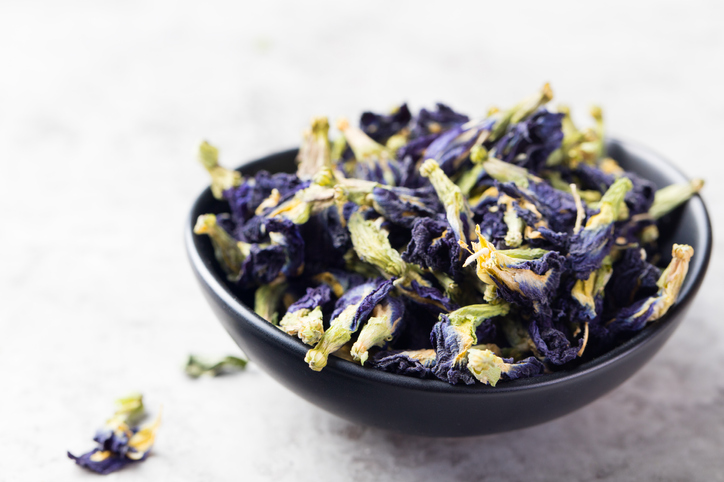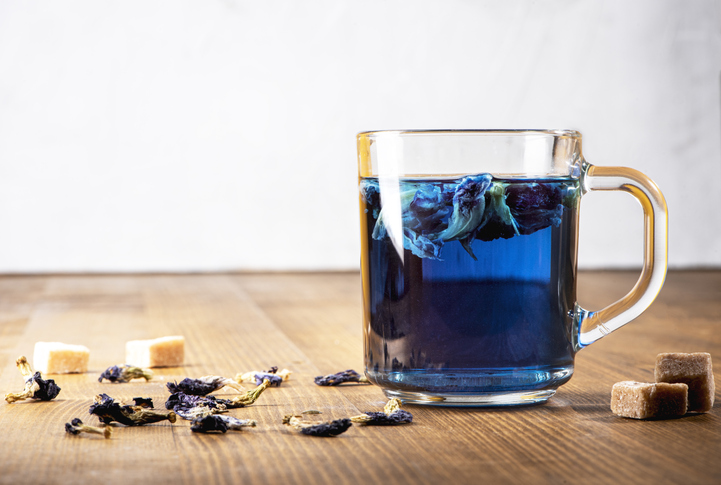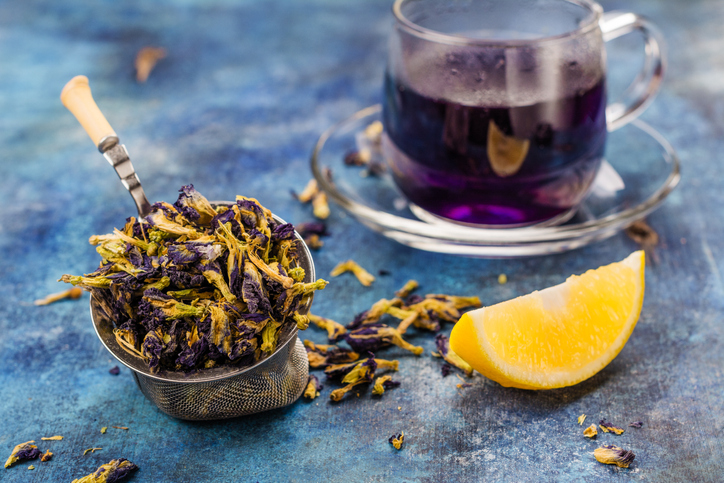Butterfly Pea Flower Tea

Butterfly pea vines, sometimes referred to as Asian pigeonwings or blue pea vines, are plants native to Southeast Asia. Due to the vine’s resilience in all kinds of soil types, the plant has since been successfully exported to countries in Europe, Africa, and the Americas. The beautiful blue flowers that the butterfly pea vines produce have long been used as a natural food coloring in Thailand, Malaysia, and Vietnam. These flowers have developed a reputation for their striking color and sensual shape. What these flowers are most famously known for, however, is their use in tea.
The dried butterfly pea blossoms produce an aromatic tea that is bright blue in color. The tea is sometimes referred to as blue tea or magical color-changing tea. That reputation for being magical is no joke! The stunning, vibrant blue of this tea looks like something produced by an artificial dye—but it’s completely natural! By mixing in citric acid (such as lemon or lime juice), the color morphs instantly from blue to purple. By experimenting with ratios of citric acid and dried blossoms, colors such as periwinkle and bright pink can be achieved.
In recent years the popularity of butterfly pea flower tea has exploded all over the globe. And that’s no surprise to us! Owing to its striking color, butterfly pea flower tea is extremely photogenic. It didn’t take long for the tea to become a sensation on the web. Pictures of butterfly pea flower lemonades and cocktails frequently popped up on websites such as Instagram and Pinterest. There are photographs of teas mid-color change, the purples and blues shifting around in the likeness of little galaxies. Videos pan across glasses of iced tea, showcasing gradients of pinks, purples, and blues. There’s no doubt about it. Butterfly pea flower tea is awesome, and people are finally finding out about it. Chamomile remains the most-loved herbal tea in the United States, but even she has to be a little jealous over butterfly pea flower’s social media success. Admittedly, a lot of that social media presence can be traced back to the unique beauty of butterfly pea flower tea. But what is good about it beyond that?
Firstly, it tastes great. The flavor is slightly earthy with a mellow sweetness. It has been described by some as being not entirely unlike a cup of green tea. Traditionally, butterfly pea flower tea is brewed with lemongrass. This blend of flavor introduces citrus overtones and creates a bolder flavor overall. In Thailand, an iced beverage known as nam dok anchan is made from the tea. It is commonly served as a drink to welcome guests or as a special spa drink. Tea in Thailand is typically sweetened. Honey and sugar are often added in generous amounts. Ginger and mint are also sometimes added to this tea. Lemon juice is almost always added at the last step of preparation so guests can see the tea’s whimsical color transformation. When properly prepared, nam dok anchan is a drink that’s both delicious and eye-catching.
If the traditional way to prepare butterfly pea flower tea isn’t for you, then experiment! The dried flower mixes well with other aromatic teas. We recommend adding dried berries and hibiscus to the mix. You can add various sweeteners, essences, and fruit juices to create a drink that is totally unique. The flavor and color produced by butterfly pea flower tea makes it a great addition to cocktails as well.
In addition to being a great-tasting tea and beverage base, butterfly pea flower tea is purported to have many health benefits. Both the plant and the flower have long been used in both Chinese and Ayurvedic medicine. Because the plant contains cyclotides, it is suspected that it is a cancer preventative. A 2015 study published in the Journal of Natural Remedies concluded that consuming butterfly pea flower tea or butterfly pea flower extract had a number of brain-boosting benefits. The article described butterfly pea flowers as having nootropic benefits, meaning it can improve cognitive function in healthy individuals. It is believed that there are anti-stress and anticonvulsant properties related to the plant. Other sources also indicate the tea could benefit hair and digestive health. The tea is, of course, caffeine free, and can be enjoyed at any time of day.
Butterfly pea flower tea can be enjoyed all year round. The sweetened liquor makes a great end-of-summer treat. We also like to enjoy it on nights where the stars are visible—it’s a bit like having a universe in a cup! This tea can be served hot as well, so it can make a great addition to a hot honey-lemon drink for cold winter nights. Regardless of your preference for how to serve it, this tea is great for entertaining guests and has a lot of amazing health benefits. There’s lots of reasons to love butterfly pea flower tea.
Just into it for the ‘gram? We don’t judge. Become the tea photographer of your dreams.



